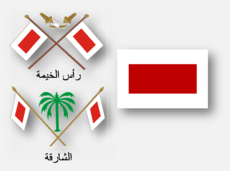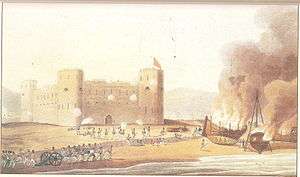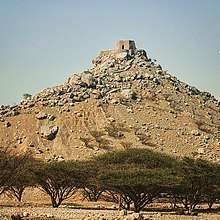Al-Qasimi
The Al Qasimi (spelled sometimes as Al Qassimi or Al Qassemi; plural: Al Qawasem Arabic: القواسم and, archaically, Joasmee) is an Arab dynasty in the Persian Gulf that rules emirate of Sharjah and emirate of Ras Al Khaimah, today forming two of the seven emirates of the United Arab Emirates. They are one of the longest reigning royal families in the Arabian peninsula and the oldest ruling house in the UAE.
| House of Al Qasimi | |
|---|---|
 Al Qassimi dynasty flag and emblems representing the emirate of Ras Al Khaimah (top) and Sharjah (bottom) | |
| Country | United Arab Emirates |
| Founded | 1722 |
| Founder | Sheikh Rahma bin Matar Al-Qasimi |
| Current head | Sultan bin Muhammad Al-Qasimi Saud bin Saqr Al-Qasimi |
| Style(s) | His/Her Highness |
| Religion | Islam |
Origin
The dynasty claim to be descended from the Prophet Muhammad.[1][2]
The Al Qasimi emerged as a maritime power based both in Ras Al Khaimah on the Southern shore of the Persian Gulf and Qishm, Bandar Abbas and Lingeh on the Persian shore in the 18th-century.
Maritime power

The Al Qasimi control of trade in the Persian Gulf area led to conflict with Oman and eventually with Oman's ally, Britain, and to the Al Qasimi being labelled by the British as pirates. This led to the identification of the southern shore of the Persian Gulf as the 'Pirate Coast', although following the General Maritime Treaty of 1820 and the 1853 Perpetual Maritime Peace, the various coastal emirates in the area became known as the Trucial States.

Following decades of incidents where British shipping had fallen foul of the aggressive Al Qasimi, a first British expeditionary force embarked for Ras Al Khaimah in 1809, the Persian Gulf campaign of 1809. This campaign led to the signing of a peace treaty between the British and Hussan Bin Rahmah, the Al Qasimi leader.[3] This treaty broke down in 1815 and, in 1819, the British mounted a second, altogether more successful, punitive campaign against the Al Qasimi in Ras Al Khaimah[4] under William Keir Grant.
The case against the Al Qasimi has been contested by the historian, author and current Ruler of Sharjah, Sultan bin Mohammed Al Qasimi in his book The Myth of Arab Piracy in the Gulf, in which he argues that the charges amount to a 'causus belli' by the East India Company, which sought to limit or eliminate the 'informal' Arab trade with India, and presents a number of internal communications between the Bombay Government and its officials, which shed doubt on many of the key charges made by British historian J.G. Lorimer in his seminal history of the affair.[5]

At the time, the Chief Secretary of the Government of Bombay, F. Warden, presented a minute which laid blame for the piracy on the Wahhabi influence on the Al Qasimi and the interference of British vessels in native affairs. Warden also successfully argued against a proposal to install the Sultan of Muscat as Ruler of the whole peninsula. Warden's arguments and proposals likely influenced the shape of the eventual treaty concluded with the Sheikhs of the Gulf coast.[6]
That 1820 treaty asserted, 'There shall be a cessation of plunder and piracy by land and sea on the part of the Arabs, who are parties to this contract, for ever.' It then goes on to define piracy as being any attack that is not an action of 'acknowledged war'. The 'pacificated Arabs' agreed, on land and sea, to carry a flag being a red rectangle contained within a white border of equal width to the contained rectangle, 'with or without letters on it, at their option'. This flag was to be a symbol of peace with the British government and each other.
The treaty having been signed by Keir Grant and all of the Trucial Rulers, the Government in Bombay made clear that while it was happy with Grant's management of the military expedition, it was most dissatisfied with his leniency over the coastal tribes and desired, 'if it were not too late, to introduce some conditions of greater stringency'. Grant's response was spirited, pointing out that to have enforced extreme measures would have meant pursuing the chiefs into the interior rather than accepting their voluntary submission. This would have contravened Grant's instructions. In the end, Bombay allowed the treaty to stand.[7]
The Al Qasimi rulers of Ras Al Khaimah (capital to 1819) and Sharjah (capital from 1820)
- Sheikh Rahma bin Matar Al Qasimi (1722–1760)
- Sheikh Rashid bin Matar Al Qasimi (1760–1777)
- Sheikh Saqr bin Rashid Al Qasimi (1777–1803)
- Sheikh Sultan bin Saqr Al Qasimi (1803–1808)
- Sheikh Hassan bin Rahma Al Qasimi (1814–1820)
- Sheikh Sultan bin Saqr Al Qasimi (1820–1866)
- Sheikh Khalid bin Sultan Al Qasimi (1866-1867)
List of Ras Al Khaimah rulers

- Sheikh Ibrahim bin Sultan Al Qasimi (1866 – May 1867)
- Sheikh Khalid bin Sultan Al Qasimi (May 1867 – 14 April 1868)
- Sheikh Salim bin Sultan Al Qasimi (14 April 1868 – 1869)
- Sheikh Humaid bin Abdullah Al Qasimi (1869 – August 1900)
- Sheikh Khalid bin Ahmad Al Qasimi (1914–1921)
- Sheikh Sultan bin Salim Al Qasimi (19 July 1921 – February 1948)
- Sheikh Saqr bin Mohammad Al Qassimi (February 1948 – 27 October 2010)
- Sheikh Saud bin Saqr Al Qasimi (27 October 2010 – present)
List of Sharjah rulers

- Sheikh Sultan bin Saqr Al Qasimi (1803-1866)
- Sheikh Khalid bin Sultan Al Qasimi (1866 – 14 April 1868)
- Sheikh Salim bin Sultan Al Qasimi (14 April 1868 – March 1883)
- Sheikh Ibrahim bin Sultan Al Qasimi (1869 – 1871)
- Sheikh Saqr bin Khalid Al Qasimi (March 1883 – 1914)
- Sheikh Khalid bin Ahmad Al Qasimi (13 April 1914 – 21 November 1924)
- Sheikh Sultan bin Saqr Al Qasimi II (21 November 1924 – 1951)
- Sheikh Saqr bin Sultan Al Qasimi (May 1951 – 24 June 1965) - first time ruling
- Sheikh Khalid bin Mohammed Al Qasimi (24 June 1965 – 24 January 1972)
- Sheikh Saqr bin Sultan Al Qasimi (25 January 1972 – 1972) - second time ruling
- Sheikh Sultan bin Muhammad Al Qasimi (1972 – 17 June 1987) - first time ruling
- Sheikh Abdulaziz bin Mohammed Al Qasimi (17–23 June 1987)
- Sheikh Sultan bin Muhammad Al Qasimi (23 June 1987 – present) - second time ruling
Current Al Qasimi rulers
- Sultan bin Muhammad Al-Qasimi, ruler of the emirate of Sharjah, UAE
- Saud bin Saqr Al Qasimi,[8] ruler of the emirate of Ras Al Khaimah, UAE
Historical flags
 Flag of the Al Qawasim prior to 1820. Flown after 1820 during war time only. The motto reads "A victory from Allah and an imminent conquest".
Flag of the Al Qawasim prior to 1820. Flown after 1820 during war time only. The motto reads "A victory from Allah and an imminent conquest". Flag of the Al Qawasim proceeding the General Maritime Treaty of 1820.
Flag of the Al Qawasim proceeding the General Maritime Treaty of 1820.
See also
- List of Sunni Muslim dynasties
External links
References
- "HH Sheikha Jawaher Bint Mohammed Bin Sultan Al Qassimi - Family". 12 May 2014. Archived from the original on 2014-05-12.
- Lorimer, John (1915). Gazetteer of the Persian Gulf Vol II. British Government, Bombay. p. 1547.
- "'Gazetteer of the Persian Gulf. Vol I. Historical. Part IA & IB. J G Lorimer. 1915' [653] (796/1782)". qdl.qa. Retrieved 13 January 2014. This article incorporates text from this source, which is in the public domain.
- "Al-Qawāsim | Arabian dynasty". Britannica.com. Retrieved 2018-12-05.
- 1939-, Sulṭān ibn Muḥammad al-Qāsimī, Ruler of Shāriqah (1986). The myth of Arab piracy in the Gulf. London: Croom Helm. ISBN 0709921063. OCLC 12583612.CS1 maint: numeric names: authors list (link)
- Lorimer, John (1915). Gazetteer of the Persian Gulf. Government of Bombay. pp. 659–660.
- Lorimer, John (1915). Gazetteer of the Persian Gulf. British Government, Bombay. pp. 673–4.
- "Ruler of Ras Al Khaimah dies".